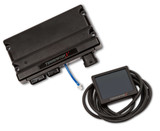Everything You Need to Know About the Mustang's Small Block 5.0
What’s so special about the 5.0? How did this engine change through the years? What is its relation to other Ford engines like the 302 and 351W? Why is this nearly 60-year-old design still a popular? Let’s take a look back on this motor’s history from its introduction, its use in the Mustang and its development into one of the most flexible engines on the market.
The Origins of the Small Block
The Ford Small Block debuted in the 1962 Ford Fairlane and Mercury Meteor with a displacement of 221 cubic inches (3.6 liters,) followed quickly by larger versions including a 260 c.i. (4.3 l) V8 in the first Mustang and a 302 c.i. (4.9 l) engine in 1968 that let the pony car meet Le Mans’ new displacement rules. The 302's four inch bore, three inch stroke and 8.2 inch deck height were kept through the small block’s production run.
Windsor vs. Cleveland
At one point, Ford’s small block and 335 engines were built at the same time using the same displacement, 351 c.i. (5.75 l,) leading owners to nickname them based on where they were built: “Windsor” or “W” for the small block and “Cleveland” or “C” for the 335. These names stuck, with most tuners referring to these engines by these plant names regardless of where they were assembled.
Initially, the Cleveland’s better head flow, larger bearing journals and higher displacement engines made it the enthusiasts’ favorite. That changed when Ford dropped the Cleveland in 1982, using the 351W in its place. This led to a shift in focus toward the Windsor, leading to the development of performance parts that not only made the Windsor superior to the Cleveland, it offers a range of performance options rivaled only by the Chevy small block.
The 5.0
When shifting to metric measurements, Ford started calling the 302 the “5.0” to avoid confusion with the 300 c.i. straight 6. The Fox body debuted with this “new” engine in 1979, but it was quickly replaced by a 4.2 liter which was intended as a stop gap until a new V6 was released.
The 5.0 as we know it was first used in 1983. This “high output” (H.O.) engine used a different firing order and small revisions throughout the engine’s design. In 1986, the engine got sequential fuel injection, bringing output up to 200 hp and 285 lb-ft. of torque, 60 hp and 35 lb-ft. more than the ‘79. In 1987, a new cylinder head and bigger throttle body brought quarter mile times into the 13s. Mass Air Flow EFI was added to ‘88 California cars and the rest of the V8s in ‘89, allowing the system to adapt to engine modifications, opening the door to greater performance. Hypereutectic pistons replaced forged pistons in ‘93, and the intake was revised for the debut of the SN95 in ‘94.
The SVT Cobra, built from ‘93 to ‘95 got GT-40 heads, a 65mm throttle body, smaller accessory pulleys and a new Cobra intake, delivering 235-240 hp. These parts are still sought after, despite falling behind the performance of modern aftermarket parts.
While the Mustang switched to the 4.6l “Mod” motor in 1996, the 5.0 continued in the Explorer until 2001. The Explorer’s engine uses a distributorless ignition and torque-focused GT-40P heads.
The Small Block Today: 5.0, 351W and the Boss
The 5.0 is a great base for a performance build, but as development has gotten more and more power out of this engine, we’re seeing the limit of what the stock block can handle. Failures are common when power reaches the 450-500 hp range. That’s still enough to make a lightweight Fox body fast, but for most of us, there isn’t such a thing as too much power. This has led builders to two alternatives: the 351W and Ford Racing’s Boss block.
The 351W was a staple of the truck market through the mid-90s, and, aside from a taller deck height, and larger head studs, is largely compatible with the 5.0, making it a go-to junkyard motor for starting a build. Since weight was less of a concern, Ford built these engines with a stronger block than the 302.
In 2010, Ford Racing restarted small block production with the Boss, a new design that uses Cleveland-sized bearing journals, stronger materials and a range of deck heights. Today, this block is offered as a direct replacement for the stock 5.0 and as part of their line of small block crate engines ranging from 302 to 460 cubic inches.
Get Your Small Block Build Started Off Right
Whether you want a little more performance from your stock Mustang or you want an engine ready for drag racing, you can get everything you need from Anderson Ford Motorsport. We’ve helped people improve the performance of their Mustangs for over 30 years, finding Ford Mustang performance parts that work and even making our own products including camshafts and intakes.
Recent Posts
-
Bringing the Fox Body Mustang into the 21st Century with Holley Terminator X
Anderson Ford Motorsport has been in the Fox Mustang performance industry since 1989. One of the bi …22nd Oct 2021 -
Roush Supercharger install on a 2019 Ford Mustang
Check out this 2019 Ford Mustang before and after we installed a Roush Supercharger. …21st Feb 2020 -
All Blower Installations are not Equal.
Why Should You Choose a Company to Install Your Blower That Has a Dyno Facility In-House?Are all de …24th Jan 2020

